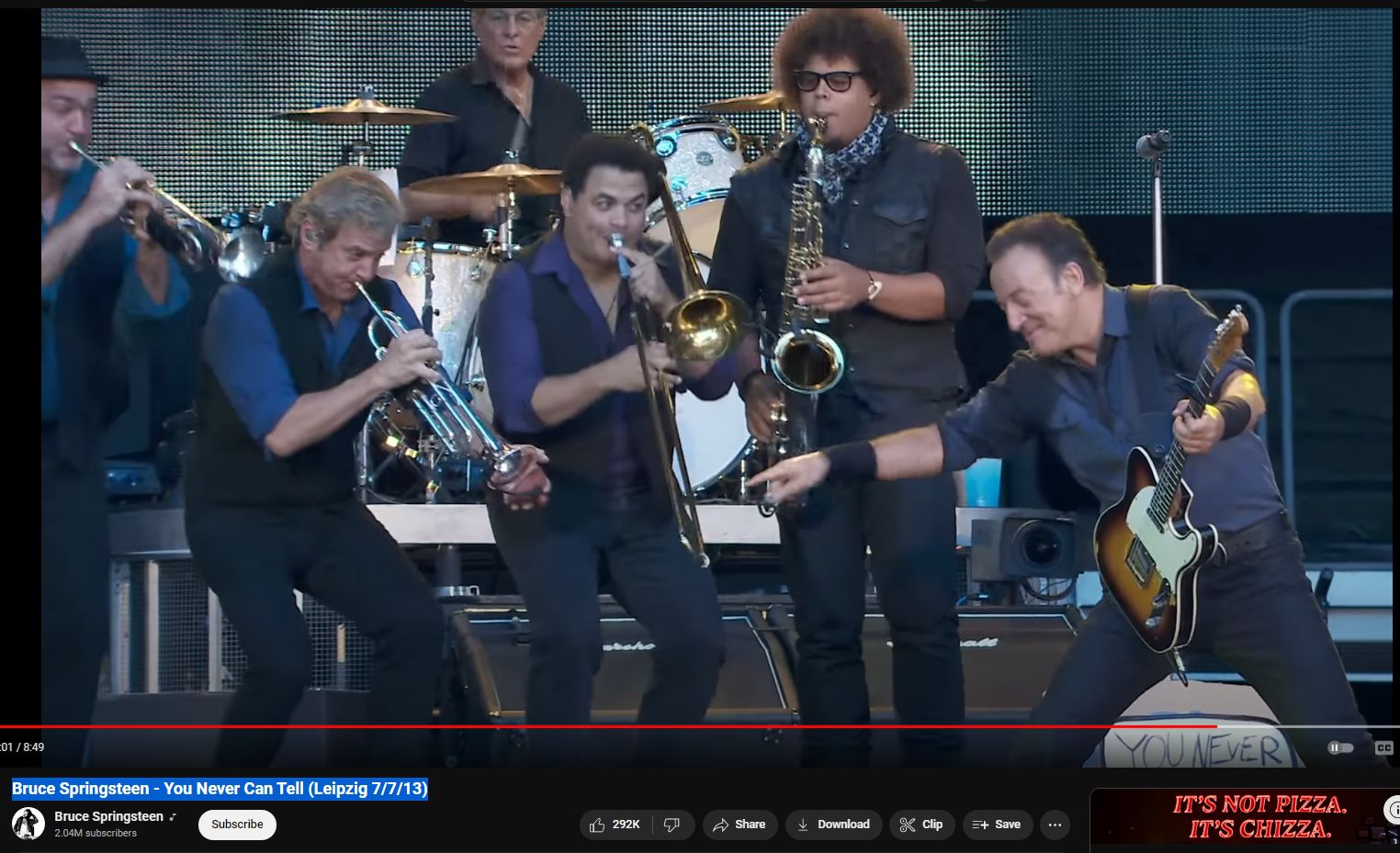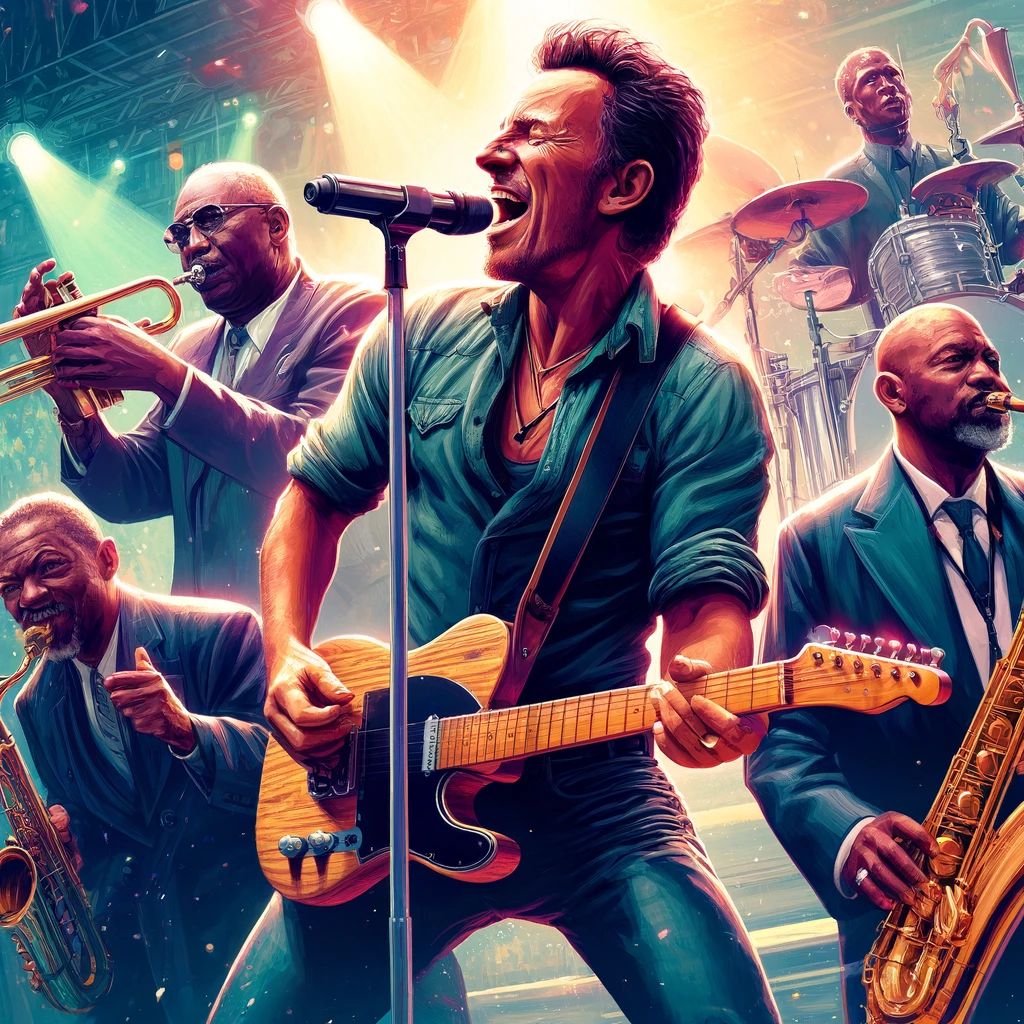You Never Can Tell Cover-tune
Bruce Springsteen’s E Street Band, known for its rock and roll prowess, also has a notable horn section that adds a distinctive layer to their sound. The inclusion of horns, particularly saxophones, has been a defining feature of their music. Clarence Clemons, the original saxophonist, was a central figure, providing iconic solos and a dynamic stage presence. The horn section contributes to the band’s energetic performances and rich, layered arrangements, blending rock with soul and jazz elements, enhancing the emotional and narrative depth of their songs.
Bruce Springsteen and the E Street Band, renowned for their rock anthems and vibrant live performances, have often incorporated robust horn sections, adding a powerful and soulful dimension to their music. The band’s use of horns has been a defining feature, especially in live concerts, where the brass section amplifies the energy and emotional depth of the performance.
The horn section, often led by Clarence Clemons on the saxophone until his passing in 2011, contributed to the band’s distinctive sound. Clemons, nicknamed “The Big Man,” was a central figure in the band, and his saxophone solos became iconic elements of Springsteen’s music. After Clemons’ death, the band expanded its horn section, including musicians like Jake Clemons (Clarence’s nephew) on saxophone, bringing a new era of horn arrangements to the band’s sound.
The inclusion of the horn section in the E Street Band reflects Springsteen’s influences from soul, R&B, and jazz, genres where brass instruments play a crucial role. The horns have the power to elevate the narrative and emotional intensity of Springsteen’s storytelling, creating a more dynamic and immersive musical experience. They add layers of richness and texture to the band’s arrangements, from the roaring sax solos to the punchy trumpet and trombone lines, showcasing the versatility and musicality of the group.
In albums like “Born to Run” and “The Wild, the Innocent & the E Street Shuffle,” the horns play a central role in the arrangement, complementing Springsteen’s lyrics and melodies with their vibrant and energetic sounds. Live performances, particularly, highlight the horn section’s impact, where extended solos and brass-driven arrangements electrify the audience, showcasing the band’s cohesive and powerful sound.

The E Street Band’s horn section not only enhances their music but also symbolizes the communal and celebratory spirit of their live shows, embodying the soul and passion that define Bruce Springsteen’s legacy in rock music. Their ability to seamlessly blend rock with elements of soul, jazz, and blues through the use of horns has cemented their status as one of the most enduring and beloved acts in the history of American music.
Bruce Springsteen’s E Street Band is iconic in the rock music world, with the drums playing a central role in defining their sound. Max Weinberg, the band’s long-time drummer, has been a cornerstone, providing powerful, steady rhythms that are both complex and driving. His drumming style, influenced by rock and roll and R&B, has contributed significantly to the band’s energetic performances.
The drumming in E Street Band songs is not just about keeping time; it’s about creating a narrative and emotional depth. Weinberg’s work on albums like “Born in the U.S.A.” and “Born to Run” showcases his ability to blend seamlessly with the band’s dynamic changes, from the explosive intros to the subtle nuances in quieter tracks. His understanding of dynamics and his ability to build tension and release it is a key element of the E Street Band’s sound.
In live performances, the drums take on an even more central role, driving the band’s high-energy concerts and creating a connection with the audience. The interplay between Weinberg and other band members, particularly during extended jams, highlights the drums as a pivotal force in the band’s music.
Beyond Weinberg’s contributions, the E Street Band’s approach to percussion has evolved, incorporating various drumming styles and additional percussionists to enrich their sound. This has allowed them to explore different musical landscapes, from the soulful grooves of “The Rising” to the folk influences in “Nebraska.”
In crafting their distinctive sound, the E Street Band, led by Springsteen’s vision and Weinberg’s rhythmic mastery, has made the drums a central, unifying element of their music, contributing to their legacy as one of rock’s most enduring and dynamic bands.
